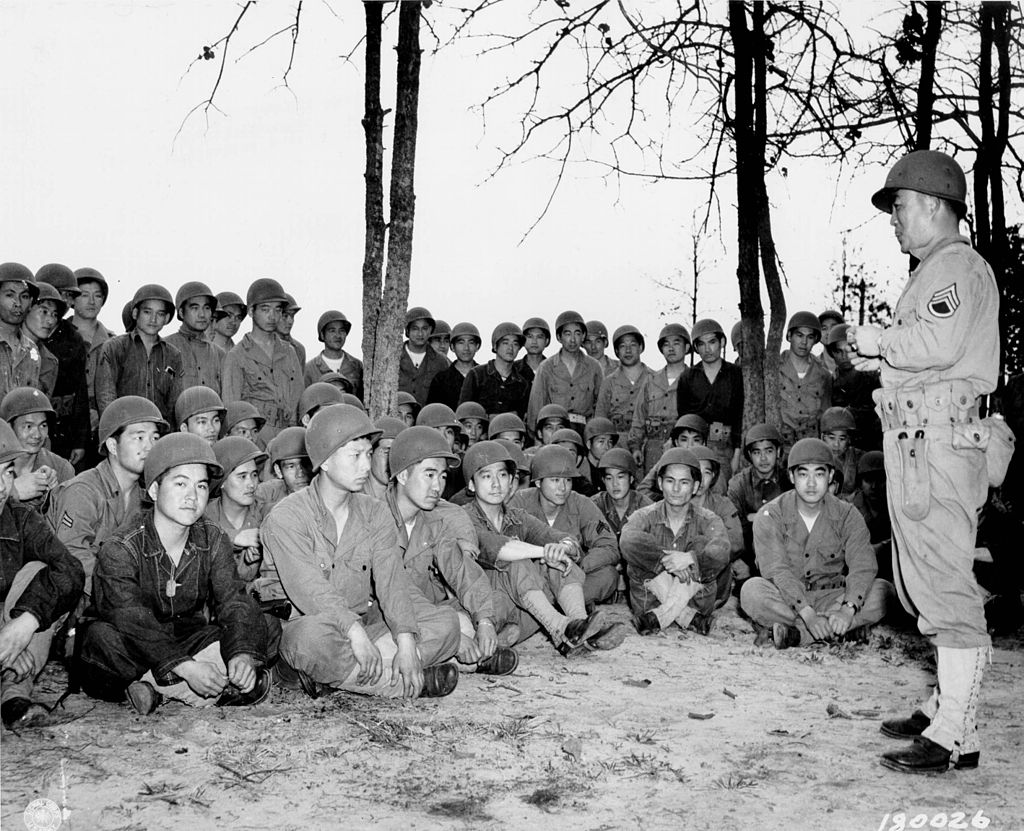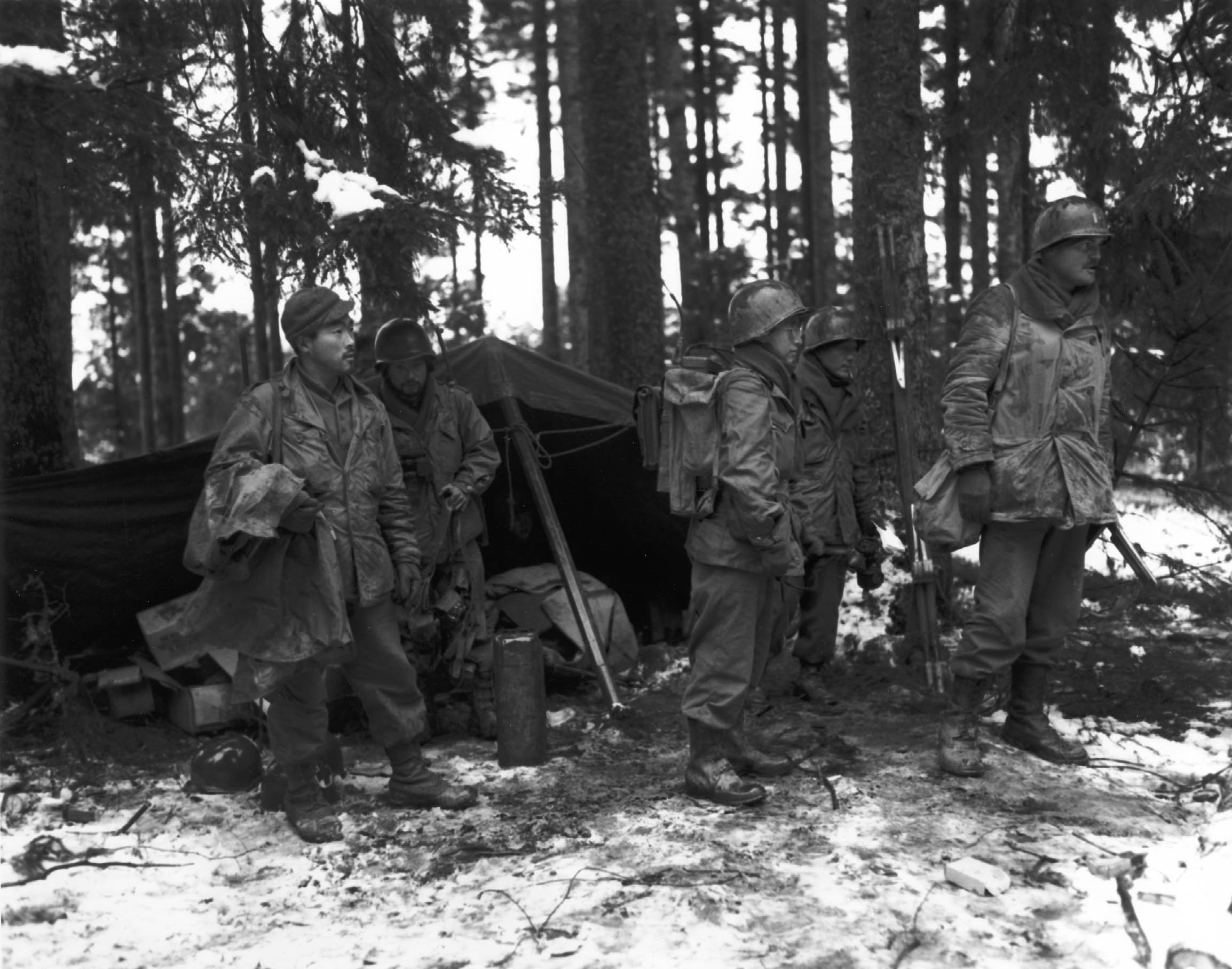The 100th Battalion was originally formed up as the Hawaii Provisional Infantry Battalion and was made up of Japanese-American draftees from the island. The men were shipped surreptitiously on three separate trains – to avoid publicity: one through Texas, one through Nebraska, and one through North Dakota. On June 16, 1942 the trains arrived at Fort McCoy, in southwest Wisconsin. For the next three months the men slept in tents and were trained in military procedures – and they had an additional duty. Of the Japanese Americans arrested in Hawaii shortly after the attack on Pearl Harbor, 172 had been sent to Camp McCoy for internment beginning in March of 1942. When the 100th arrived at the Camp it was their duty to release the prisoners for exercise, an interesting predicament. Kenneth Kaneko, a soldier of the 100th, recalls that one of the prisoners was in fact the father of one of the soldiers of the 100th.
Detaining other Japanese Americans was not the only strange position the members of the 100th were put in. When allowed on leave the local townspeople gave the soldiers cold stares and one local farmer, when he first saw a nisei soldier, called the state police and told them the Japanese had landed in the area by parachute. In November members of the Texan Second Division arrived at the Camp and after some name-calling fighting broke out. The Texans, much larger than the nisei, severely underestimated their opponents, and of the 39 troops which went to the infirmary that night, only one was a nisei, and that soldier had been beamed over the head by a Texan MP who was supposed to have been breaking up the fight. In what was perhaps the most atrocious circumstance in which the Nisei had to live, several were sent to an island in the Pacific and taught the dogs to hate Japanese by beating them. Despite this, the war cry of the 100th was “Remember Pearl Harbor.” Despite the obvious anti-Japanese connotations of this statement, the 100th wanted the Army to know where their loyalties lay. Soon the mistakes were corrected in Wisconsin at least and the community began bringing in the soldiers for dinner.

100th Infantry soldiers receiving training in the use of grenades in 1943
U.S. Army Photo – http://www.army.mil/cmh-pg/topics/apam/100-Tng-Photos.htm
The 100th was an orphan Battalion, and an overweight one at that. All battalions were attached to a Regiment or Brigade along with two or three others, but the 100th was the only battalion in the US Army without a parent, which indicated the military didn’t know what to do with the unit. The 100th also was oversized, having six companies to the usual four, and this also gave the implication that the Army had just dumped all of the Japanese-Americans in one unit and placed them in a corner somewhere where they couldn’t do any harm. The 100th even had Caucasian officers in command, although this was easily explainable as there were few Japanese-Americans who had undergone training to become officers. After some time, however, the unit was assigned to participate in maneuvers in Louisiana.
Before leaving for the Deep South, Colonel Turner warned the unit that there were still ample prejudices against blacks in the South, but even this was not enough to prepare the men for their experience in Louisiana. In the South the 100th participated in maneuvers with the 442nd Regimental Combat Team, a unit made up of Japanese American volunteers who were generally less well behaved than the men of the 100th. Although the prejudice against blacks surprised the 100th, it appalled the 442nd, who went so far as to get into fights and steal the public segregated busses that took them into town. From this experience, however, the 100th gained the reputation of a veteran unit, whereas the 442nd appeared as mere children to those in the 100th.
After some time in Louisiana, the 100th returned to Hawaii where they visited old friends and organized baseball games before they were shipped off to the Mediterranean. On August 21, 1943 the 100th Battalion was loaded onto the James Parker, and was taken to Oran, the second largest port of Algeria in North Africa. The 100th’s orders were discussed for some time, as the leaders of the Allied forces knew not what to do with the unit. Eventually the 100th joined the Thirty-Fourth Division and was quickly accepted due to its baseball abilities. In fact, the 100th won the North African baseball tournament, beating every American team on the coast. Following the tournament the 100th landed on the shores of Italy, and henceforth was hounded by packs of reporters and journalists, eager to get the scoop on the unit.
The engagements in which the 100th fought were some of the bloodiest of the war, but the soldiers proved themselves to be worthy of great praise. Although white men commanded them, it soon became obvious that the unit was indeed commanded by the enlisted men – and for good reason. Soldiers of the 100th proved themselves to be able leaders in battle, correcting their superiors on numerous occasions and eventually gaining the upper hand one the Caucasians were proven wrong time and time again. The 100th fought their first engagement before the sun rose on September 29th. Thanks to the ingenuity of a Korean-American lieutenant Kim the unit flushed out their first machine gunners nest with a banzai charge. In a second engagement soon after that day the unit approached some tanks on a road. Whereas the commanding officer commanded the troops to continue ahead on the road, Lieutenant Kim defied that order and took his men to the side of the road. Eventually the battalion commander had to promise the Lieutenant that he would take full responsibility for every man that died on that road. As the men approached the German positions, one died and seven were wounded. If Kim’s platoon had gone on the side of the road, it is very possible that none of those casualties could have occurred.
In the beginning of October the 100th was to make a river crossing under fire during the night. The rainy season had begun in Italy and the weather was worse that autumn than it had been in decades. The 100th crosses the muddy river and was commanded in the wrong direction. Eventually Lieutenant Kim saved the day by finding the correct path to their destination after flushing out some more German machine gun positions. The Caucasian officers of the 100th were known not to stick their necks out, and always allowed the Nisei to lead, perhaps in more ways than one. It is this fact, along with the bravery and skills of the Nisei, which have given such high honors. Perhaps the most daring feat of the 100th, however, was their assault on Cassino.
Monte Cassino was a monastery built on the peak of a mountain and was perhaps the most impenetrable spot militarily in the entire Italian boot. After crossing a river of mud in the dark under fire, the remaining members of the 100th had to clean up machine gun post before moving on despite the mud everywhere. Through the minefields they went on approach to the mountain. Unfortunately, the other regiments of the Thirty-Fourth Division had been completely repulsed by the Germans and had not made it across, and so the 100th had to retreat. Their entire day, advance, and their numerous losses were for naught. On February 8, 1944 the 100th once again made an assault on the mountain, but was again forced to retreat, as other units could not reach their objectives. The assault on Monte Cassino is the most famous engagement (engagements lasting 1 to 5 days) of World War II (at least to US historians) with the single exception of Guderian’s attack on Sedan. The first Japanese-American POW was taken by the Germans at this time, and he and every soldier of the 100th and 442nd were treated with respect and dignity by the Germans, although they were often why they were fighting for the Americans and not Japan. Monte Cassino also saw the first cases of shell shock among Nisei soldiers, which was much less common than in Caucasian units.
After the raids on Cassino, the 100th was pulled back to regroup as it had been heavily depleted by this time. After a few weeks of rest the 100th had another nearly impossible chore. The American landing at Anzio was perhaps the riskiest maneuver of the war. The Germans sent their best tanks and most elite soldiers against the beachhead, but the Army, including the 100th, held out. Make no mistake; the story of the 100th is not similar to any other’s. The 100th was placed in the most difficult positions the US could find for them and was even under one of the ten worst generals of all time, General Mark Clark, as according to West Point’s Officer’s Companion to Military History. After Anzio the 100th was continuously manning the front lines in a push for Rome. Until, that it, they were near the city. The 100th was ordered to halt just before Rome so the rest of the US Army could claim the glory. Following a short stay in Rome, the 100th was attached to the 442nd.

